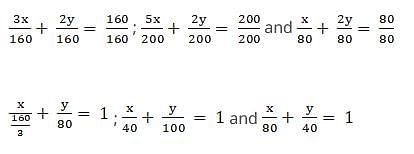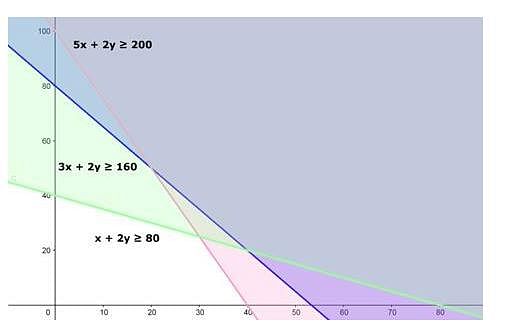JEE Exam > JEE Questions > The maximum value of Z = 4x + 3y subjected to...
Start Learning for Free
The maximum value of Z = 4x + 3y subjected to the constraints 3x + 2y ≤ 160, 5x + 2y ≤ 200, x + 2y ≤ 80 ;
x, y ≥ 0 attains at
x, y ≥ 0 attains at
- a)x = 40, y = 0
- b)x = 40, y = 25
- c)x = 0, y = 25
- d)x = 30. y = 25
Correct answer is option 'D'. Can you explain this answer?
| FREE This question is part of | Download PDF Attempt this Test |
Verified Answer
The maximum value of Z = 4x + 3y subjected to the constraints 3x + 2y ...
Given object function is
Z = 4x+3y
Constraints are
3x + 2y ≥ 160
5x + 2y ≥ 200
x + 2y ≥ 80
x ≥ 0
y≥ 0.
Consider, the inequalities as equalities for some time,
3x + 2y = 160 ; 5x + 2y = 200 and x + 2y = 80
If we convert these into intercept line format equations, we get,

From this form of line, we can say that the line 3x + 2y = 160 meets the x-axis at (,0) and y-axis at (0,80).
This shows the inequality 3x + 2y ≥ 160 holds.
Similarly, from the intercept line format, we can say that the line 5x + 2y = 200 meets the x-axis at (40,0) and y-axis at (0,100).
This shows the inequality 5x + 2y ≥ 200 holds .
Similarly from the intercept line format, we can say that the line x + 2y = 80 meets the x-axis at (80,0) and y-axis at (0,40).
This shows the inequality x + 2y ≥ 80 holds .
Now considering the inequalities, x ≥ 0 and y ≥ 0, this clearly shows the region where both x and y are positive. This represents the 1st quadrant of the graph.
So, the solutions of the LPP are in the first quadrant where the inequalities meet.

We can clearly see that, there is no area in the 1st quadrant where all the three inequalities met.
This clearly says that there is no solution for the LPP with the given constraints.
Hence the option D, is the solution to the problem.
View all questions of this test
Z = 4x+3y
Constraints are
3x + 2y ≥ 160
5x + 2y ≥ 200
x + 2y ≥ 80
x ≥ 0
y≥ 0.
Consider, the inequalities as equalities for some time,
3x + 2y = 160 ; 5x + 2y = 200 and x + 2y = 80
If we convert these into intercept line format equations, we get,
[Dividing the whole equation with the right hand side number of the equation]

From this form of line, we can say that the line 3x + 2y = 160 meets the x-axis at (,0) and y-axis at (0,80).
This shows the inequality 3x + 2y ≥ 160 holds.
Similarly, from the intercept line format, we can say that the line 5x + 2y = 200 meets the x-axis at (40,0) and y-axis at (0,100).
This shows the inequality 5x + 2y ≥ 200 holds .
Similarly from the intercept line format, we can say that the line x + 2y = 80 meets the x-axis at (80,0) and y-axis at (0,40).
This shows the inequality x + 2y ≥ 80 holds .
Now considering the inequalities, x ≥ 0 and y ≥ 0, this clearly shows the region where both x and y are positive. This represents the 1st quadrant of the graph.
So, the solutions of the LPP are in the first quadrant where the inequalities meet.
Now by plotting all the graphs 3x + 2y ≥ 160 , 5x + 2y ≥ 200 and x + 2y ≥ 80 we get the below graph.

We can clearly see that, there is no area in the 1st quadrant where all the three inequalities met.
This clearly says that there is no solution for the LPP with the given constraints.
Hence the option D, is the solution to the problem.
Most Upvoted Answer
The maximum value of Z = 4x + 3y subjected to the constraints 3x + 2y ...
Problem Statement:
Find the maximum value of Z = 4x + 3y subjected to the constraints 3x - 2y ≤ 160, 5x - 2y ≤ 200, x - 2y ≤ 80; x, y ≥ 0
Solution:
We can solve this problem using the graphical method of linear programming.
Step 1: Graph the constraints:
Plotting the three constraints on graph we get:

Step 2: Find the feasible region:
The feasible region is the common region that satisfies all the constraints. It is the shaded region in the graph.

Step 3: Find the corner points of the feasible region:
The corner points of the feasible region are the vertices of the shaded region. The corner points are (0, 0), (0, 80), (30, 55), (40, 25) and (64, 0).
Step 4: Evaluate Z at each corner point:
Z = 4x + 3y
At (0, 0), Z = 4(0) + 3(0) = 0
At (0, 80), Z = 4(0) + 3(80) = 240
At (30, 55), Z = 4(30) + 3(55) = 245
At (40, 25), Z = 4(40) + 3(25) = 235
At (64, 0), Z = 4(64) + 3(0) = 256
Step 5: Compare the values of Z at each corner point:
The maximum value of Z is at (30, 55) which is 245.
Therefore, the correct option is (D) x = 30, y = 25.
Find the maximum value of Z = 4x + 3y subjected to the constraints 3x - 2y ≤ 160, 5x - 2y ≤ 200, x - 2y ≤ 80; x, y ≥ 0
Solution:
We can solve this problem using the graphical method of linear programming.
Step 1: Graph the constraints:
Plotting the three constraints on graph we get:

Step 2: Find the feasible region:
The feasible region is the common region that satisfies all the constraints. It is the shaded region in the graph.

Step 3: Find the corner points of the feasible region:
The corner points of the feasible region are the vertices of the shaded region. The corner points are (0, 0), (0, 80), (30, 55), (40, 25) and (64, 0).
Step 4: Evaluate Z at each corner point:
Z = 4x + 3y
At (0, 0), Z = 4(0) + 3(0) = 0
At (0, 80), Z = 4(0) + 3(80) = 240
At (30, 55), Z = 4(30) + 3(55) = 245
At (40, 25), Z = 4(40) + 3(25) = 235
At (64, 0), Z = 4(64) + 3(0) = 256
Step 5: Compare the values of Z at each corner point:
The maximum value of Z is at (30, 55) which is 245.
Therefore, the correct option is (D) x = 30, y = 25.
Attention JEE Students!
To make sure you are not studying endlessly, EduRev has designed JEE study material, with Structured Courses, Videos, & Test Series. Plus get personalized analysis, doubt solving and improvement plans to achieve a great score in JEE.

|
Explore Courses for JEE exam
|

|
Similar JEE Doubts
The maximum value of Z = 4x + 3y subjected to the constraints 3x + 2y ≤ 160, 5x + 2y ≤ 200, x + 2y ≤ 80 ;x, y ≥ 0 attains ata)x = 40, y = 0b)x = 40, y = 25c)x = 0, y = 25d)x = 30. y = 25Correct answer is option 'D'. Can you explain this answer?
Question Description
The maximum value of Z = 4x + 3y subjected to the constraints 3x + 2y ≤ 160, 5x + 2y ≤ 200, x + 2y ≤ 80 ;x, y ≥ 0 attains ata)x = 40, y = 0b)x = 40, y = 25c)x = 0, y = 25d)x = 30. y = 25Correct answer is option 'D'. Can you explain this answer? for JEE 2024 is part of JEE preparation. The Question and answers have been prepared according to the JEE exam syllabus. Information about The maximum value of Z = 4x + 3y subjected to the constraints 3x + 2y ≤ 160, 5x + 2y ≤ 200, x + 2y ≤ 80 ;x, y ≥ 0 attains ata)x = 40, y = 0b)x = 40, y = 25c)x = 0, y = 25d)x = 30. y = 25Correct answer is option 'D'. Can you explain this answer? covers all topics & solutions for JEE 2024 Exam. Find important definitions, questions, meanings, examples, exercises and tests below for The maximum value of Z = 4x + 3y subjected to the constraints 3x + 2y ≤ 160, 5x + 2y ≤ 200, x + 2y ≤ 80 ;x, y ≥ 0 attains ata)x = 40, y = 0b)x = 40, y = 25c)x = 0, y = 25d)x = 30. y = 25Correct answer is option 'D'. Can you explain this answer?.
The maximum value of Z = 4x + 3y subjected to the constraints 3x + 2y ≤ 160, 5x + 2y ≤ 200, x + 2y ≤ 80 ;x, y ≥ 0 attains ata)x = 40, y = 0b)x = 40, y = 25c)x = 0, y = 25d)x = 30. y = 25Correct answer is option 'D'. Can you explain this answer? for JEE 2024 is part of JEE preparation. The Question and answers have been prepared according to the JEE exam syllabus. Information about The maximum value of Z = 4x + 3y subjected to the constraints 3x + 2y ≤ 160, 5x + 2y ≤ 200, x + 2y ≤ 80 ;x, y ≥ 0 attains ata)x = 40, y = 0b)x = 40, y = 25c)x = 0, y = 25d)x = 30. y = 25Correct answer is option 'D'. Can you explain this answer? covers all topics & solutions for JEE 2024 Exam. Find important definitions, questions, meanings, examples, exercises and tests below for The maximum value of Z = 4x + 3y subjected to the constraints 3x + 2y ≤ 160, 5x + 2y ≤ 200, x + 2y ≤ 80 ;x, y ≥ 0 attains ata)x = 40, y = 0b)x = 40, y = 25c)x = 0, y = 25d)x = 30. y = 25Correct answer is option 'D'. Can you explain this answer?.
Solutions for The maximum value of Z = 4x + 3y subjected to the constraints 3x + 2y ≤ 160, 5x + 2y ≤ 200, x + 2y ≤ 80 ;x, y ≥ 0 attains ata)x = 40, y = 0b)x = 40, y = 25c)x = 0, y = 25d)x = 30. y = 25Correct answer is option 'D'. Can you explain this answer? in English & in Hindi are available as part of our courses for JEE.
Download more important topics, notes, lectures and mock test series for JEE Exam by signing up for free.
Here you can find the meaning of The maximum value of Z = 4x + 3y subjected to the constraints 3x + 2y ≤ 160, 5x + 2y ≤ 200, x + 2y ≤ 80 ;x, y ≥ 0 attains ata)x = 40, y = 0b)x = 40, y = 25c)x = 0, y = 25d)x = 30. y = 25Correct answer is option 'D'. Can you explain this answer? defined & explained in the simplest way possible. Besides giving the explanation of
The maximum value of Z = 4x + 3y subjected to the constraints 3x + 2y ≤ 160, 5x + 2y ≤ 200, x + 2y ≤ 80 ;x, y ≥ 0 attains ata)x = 40, y = 0b)x = 40, y = 25c)x = 0, y = 25d)x = 30. y = 25Correct answer is option 'D'. Can you explain this answer?, a detailed solution for The maximum value of Z = 4x + 3y subjected to the constraints 3x + 2y ≤ 160, 5x + 2y ≤ 200, x + 2y ≤ 80 ;x, y ≥ 0 attains ata)x = 40, y = 0b)x = 40, y = 25c)x = 0, y = 25d)x = 30. y = 25Correct answer is option 'D'. Can you explain this answer? has been provided alongside types of The maximum value of Z = 4x + 3y subjected to the constraints 3x + 2y ≤ 160, 5x + 2y ≤ 200, x + 2y ≤ 80 ;x, y ≥ 0 attains ata)x = 40, y = 0b)x = 40, y = 25c)x = 0, y = 25d)x = 30. y = 25Correct answer is option 'D'. Can you explain this answer? theory, EduRev gives you an
ample number of questions to practice The maximum value of Z = 4x + 3y subjected to the constraints 3x + 2y ≤ 160, 5x + 2y ≤ 200, x + 2y ≤ 80 ;x, y ≥ 0 attains ata)x = 40, y = 0b)x = 40, y = 25c)x = 0, y = 25d)x = 30. y = 25Correct answer is option 'D'. Can you explain this answer? tests, examples and also practice JEE tests.

|
Explore Courses for JEE exam
|

|
Suggested Free Tests
Signup for Free!
Signup to see your scores go up within 7 days! Learn & Practice with 1000+ FREE Notes, Videos & Tests.
























